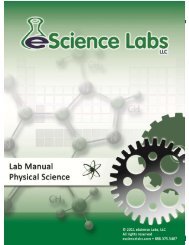Lab Manual - eScience Labs
Lab Manual - eScience Labs
Lab Manual - eScience Labs
Create successful ePaper yourself
Turn your PDF publications into a flip-book with our unique Google optimized e-Paper software.
<strong>Lab</strong> 7: Osmosis<br />
• To test that no soluon can leak out, add a few drops of water and look for water leakage.<br />
Make sure you pour the water out before connuing to the next step.<br />
5. Repeat steps 2-4 with the three remaining dialysis tubes, using each of the three remaining<br />
bead colors (Figure 3).<br />
6. Table 1 provides a disncon as to what bead belongs to which tube. Using a 10mL graduated<br />
cylinder, measure and fill the appropriate dialysis bag with the designated concentraon of sucrose<br />
soluon (3%, 15% or 30%) by adding the volumes of sucrose and water listed in the table<br />
below.<br />
Table 1: How to Make a Serial Diluon of Sucrose<br />
Bead Color Bag Number Stock Sucrose Soluon Water<br />
Yellow Bag #1: 30% sucrose 10mLs 0mLs<br />
Red Bag #2: 15% sucrose 5mLs 5mLs<br />
Blue Bag #3: 3% sucrose 1mL 9mLs<br />
Green Bag #4: 3% sucrose 1mL 9mLs<br />
7. Rinse the outside of the bags with water to remove any remaining sucrose.<br />
8. Pour 150mL of the stock sucrose soluon (30%) into the 250mL beaker (beaker #1). Using the<br />
graduated cylinder, measure 20mLs of the stock sucrose soluon and 180mL of water to create<br />
a 3% sucrose soluon and place it into the 250mL beaker (beaker #2).<br />
9. Place bags #1-3 (red, blue, yellow) into beaker 2 and bag #4 (green) into beaker 1 (Figure 4).<br />
Figure 4: The dialysis<br />
bags are filled with<br />
varying concentra-<br />
ons of sucrose solu-<br />
on and placed in one<br />
of two beakers.<br />
77
















